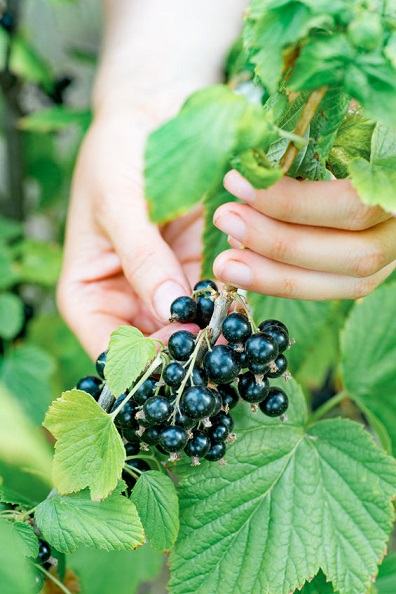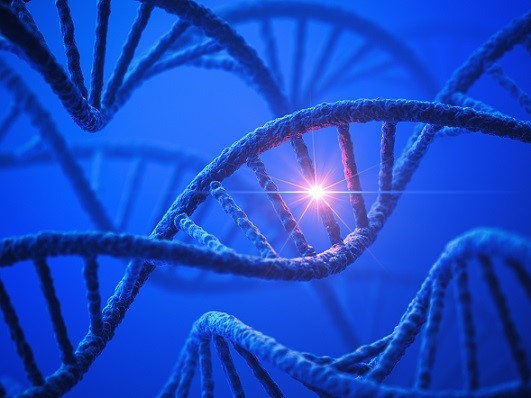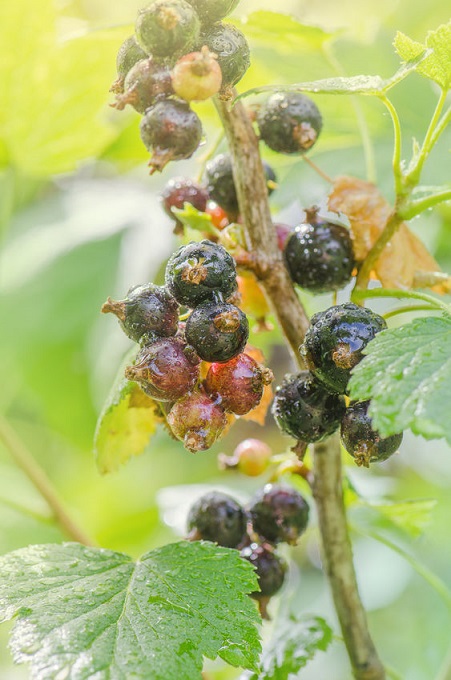 Here is a riddle. What is the common blackcurrant best used for? Is it one, a tasty fruit squash from the local supermarket?
Here is a riddle. What is the common blackcurrant best used for? Is it one, a tasty fruit squash from the local supermarket?
Is it two, flavouring purple Skittles in Europe and Australia, explaining why America’s grape-flavoured version tastes so different? Or is it three, keeping British children supplied with vitamin C during world war 2 when German U-boats disrupted orange shipments?
The answer is none of the above. Blackcurrants are best for slowing ageing.
According to a new 2018 study, blackcurrants can increase the coveted skin proteins collagen, elastin, and hyaluronic acid, all in one tidy package.
Blackcurrants would have looked promising for acne anyway. Their deep purple colour is a manifestation of plentiful anthocyanin antioxidants, and their unique flavour indicates unique compounds. Vitamin C three times higher than strawberries is the icing on the cake, but this study takes things to another level.
A hidden power
In two older experiments, a dedicated blackcurrant team had already detected strong estrogenic powers. Now, after years of obsession, the do or die moment had come.
Suspense was mounting, as they finally tested the skin directly. Scientists created a blackcurrant extract (BCE) combined with blackcurrant’ four main anthocyanin antioxidants: cyanidin-3-glucoside, cyanidin-3-rutinoside, delphinidin-3-rutinoside, and delphinidin-3-glucoside.
While their hearts pounded with anticipation, they conducted 1) a topical experiment on female human skin cells, and 2) an oral supplement fed to living, breathing rats. The animals were ovariectomized, destroying their natural estrogen production.
They monitored 1) ovariectomized rats taking 3% blackcurrant plus anthocyanins, 2) ovariectomized rats taking nothing, or 3) normal, healthy rats taking nothing. The rats had unlimited access to food and water (no, I don’t know how to sign up), making it an even experiment. They lived in a house with 12hr day/night cycle, mimicking sunlight; this is important because UV radiation can subtly affect collagen production.
After 3 months, the blackcurrant rats had 50% thicker collagen than the control ovariectomized rats.
The healthy rats were also high, showing that estrogen was a partial catalyst, but the blackcurrant group defeated them too. Elastin, the skin protein behind suppleness, was “clearly greater“. So was hyaluronic acid, your natural moisture containers, vital for hydration and proper skin barrier function.
As for the human skin samples? Type 1 and type 3 collagen proteins, and elastin increased after both blackcurrant extract and anthocyanin application. Elastin, hyaluronic acid, and collagen are arguably the holy trinity of bright and youthful skin, despite the importance of vitamin A and antioxidants as well. All decline with age, and all are pursued to the ends of the earth by glow enthusiasts.
The key, it seemed, was the hormone estrogen. Blackcurrant extract stimulated both estrogen receptor alpha (ERa) and beta (ERb), as strongly as estriadol (estrogen) itself. The anthocyanins were thus deemed to be phytoestrogens, natural estrogen mimics like the feared isoflavones in soybeans. For men, I’d never recommend phytoestrogens, but topically, and for women orally, they’re a great secret.
Blackcurrant switches on youth genes
 Why does estrogen alteration matter? Because downstream, a bunch of skincare genes connected to estrogen also increased.
Why does estrogen alteration matter? Because downstream, a bunch of skincare genes connected to estrogen also increased.
In human cells, blackcurrant extract increased collagen type three alpha one (COL3A1) 1.5 fold. At high doses, it increased collagen type 1 alpha 1 (COL1A1), and ELN, the elastin gene.
The HAS3 gene rose 1.5 fold, while MMP12 and HYAL3 fell 1.5 fold and 1.6 fold respectively. The most shocking increase was the TIMP3 gene, rising 5.6 fold.
Getting confused? Here are the main characters explained..
MMP12 – matrix-metallo protein 12. MMPs are a big family of protein degrading enzymes in the skin. All collagen molecules gradually degrade due to free radical damage, chipping away and passing their sell by date. It’s therefore for MMPs vital to recycle them, but if unrestrained, your collagen levels can plummet. Different MMPs have different roles, and MMP12 is the single most effective against old elastin. There’s actually a condition called “solar elastosis” where UVA radiation decreases your elastin levels, and MMP12 is observed to increase simultaneously, in a striking correlation. Another name for MMP12 is macrophage metalloelastase.
Collagen type 1 – the main structural protein in human skin. Declining levels cause wrinkles, weaker skin and fragile sunlight defences. Direct supplements are furiously debated these days. It differs to type 2 collagen, found in joints and cartilage.
Collagen type 3 – found in skin again, but provides a scaffolding for collagen type 1, which later crosslinks to form stronger, mature layers, like an apprentice that outstrips his master. Type 3 is vital for the earliest stages of wound healing, before type 1 collagen takes over after 1-3 weeks.
HAS3 – hyaluronan synthase 3. This gene family manufactures all hyaluronan, the precursor to hyaluronic acid. There’s three types in human skin, HAS1, HAS2, and HAS3, but even in 2020, the differences are shrouded in mystery. One is that HAS3’s hyaluronan molecules are smaller. Meanwhile, HYAL3 is like MMPs; a gene that recycles fragile hyaluronic acid before it becomes a liability.
TIMP – the puppet master behind the puppet master. While MMPs manipulate collagen, TIMP3 manipulates MMPs, creating metalloproteinase inhibitor 3 which blocks them. That’s not all though; TIMP3 is a gene strongly connected to sunlight. It falls in direct response to UVB radiation, and might explain the weathered wrinkle look pro Australian golfers get. Some are dubbing this the skin’s circadian rhythm, like the sleep cycle circadian rhythm, where the sun guides your drowsiness and alertness.
In the living rats, these genes weren’t examined, but their newfound collagen armour proved that the alterations translated.
The conclusion: “dietary administration of 3% BCE… increased skin levels of collagen, elastin, and hyaluronic acid“. The humble blackcurrant, flavouring of fruit squash everywhere, is potentially the fountain of youth. Estrogen makes it all possible.
In fact, for some ageing proteins, blackcurrant was better than estrogen. This hints at bonus powers, or that the anthocyanins stimulate estrogen receptors in a particularly targeted way for skincare.
There’s plenty of indirect benefits for acne like wound healing. Otherwise, this adds up to A) a glowing and bright skin tone, an illusion of calmer existing acne, and an aura of skinvincibility. Or B) jealousy on every street corner, people mistaking your age by 10 years, and possible imprisonment due to accusations of vampirism.
Older studies back it up
That’s assuming that the study can be trusted, of course. The great news is that the phytoestrogen properties are rock solid, supported by two older studies.
In 2015, blackcurrant extract fed to rats was found to stimulate estrogen receptor alpha (study). Human endothelial cells and female rats were tested, and the formation of MCF-7 cancer cells accelerated, which depend thrive on estrogen. It sounds dodgy, but it reinforces the skincare theory.
Through a microscope, cyanidin-3-glucose and company bound to the receptor like a key, its molecular shape perfectly matched. Their binding affinity was less than estrogen, but equalled three other phytoestrogens: naringenin in grapefruit, genistein, and resveratrol from grapes. Interestingly, blackcurrant extract was stronger than (the same 4) isolated anthocyanins, hinting at other estrogenic compounds.
However, the next study was better. Compared to ERa, blackcurrant and its anthocyanins stimulated ER-beta particularly effectively. This is promising healthwise; while ERa encourages cancer cells, ERb inhibits them.
But even better, ERb seems to be particularly active in the skin (2004 study), controlling the very proteins like collagen and elastin we’ve been discussing.
ERb is just as active in men as women. Compared to ERa, the shape of ERb receptors seemed particularly fitted to blackcurrant’s delphinidin and cyanidin anthocyanins.
We only have one skincare study, but the scientific foundation couldn’t be sturdier.
Advantages of the study
 The methodology was solid, apart from the really obvious factors like not being tested on walking, talking human beings.
The methodology was solid, apart from the really obvious factors like not being tested on walking, talking human beings.
The scientists were optimistic: “we did not administer blackcurrants to humans, but long-term ingestion is expected to be effective“. The similarities to the human cells were striking, and the fact it was on animals at all is a huge advantage.
When a study on dairy and acne drops in our lap, the question answers itself, but here, we’re talking genes and obscure proteins. Such scientific gobbledegook might not translate into the real world, so its great to have proof. We know the outcome and the mechanism in one fell swoop.
Something you might know is that phytoestrogens are hardly rare. Dozens exist in nature, including resveratrol in grapes, genistein in fava beans, and lignans in tea. Normally, a single new phytoestrogen wouldn’t be worth the fuss, but blackcurrant is rarer: a phytoestrogen specifically proven to impact acne.
One potential problem is that the only rat group receiving blackcurrant was ovariectomized.
Therefore, the benefits could only work in women with non-existent estrogen. 4 groups would have been perfect. However, the skin’s collagen still thwarted the healthy rats taking nothing, just by a smaller margin.
The most promising was blackcurrant’s superiority to estrogen for increasing collagen, which hints at powers totally outside the realm of hormones. An anthocyanin like delphinidin-3-glucoside could easily inhibit MMPs directly. Who knows; blackcurrant could be particularly incredible at defending collagen proteins from scorching sunlight.
A crack in the armour scientists confessed to was unrealistic quantities, unobtainable by simply swallowing blackcurrants. 100 grams is loaded with 304.91mg of delphinidin 3-O-rutinoside, but it might still fall short. Topically, however, it’s dramatically easier, because everything is concentrated in your face. You can bypass pointless organs like your eyes, lungs and heart (who cares about them). Orally, a dedicated supplement would crank things up, and judging by the results, I think it would be worth the splurge.
What about the failures?
The first worry is that some genes were bit part players, not in full control.
For example, MMP12 is undoubtedly important for elastin and stretchiness, but it falls short of MMP1, the master recycler of collagen (hence why it’s number one). Likewise for MMP3, effectively a “pro-MMP” which stimulates all the others. It’s like catching a mafia boss’s henchmen, but never pinning anything on the head honcho himself.
But examining the detailed results, the MMP1 gene actually did fall, by 1.4 fold. Their threshold for significance was simply 1.5 fold.
Furthermore, the massively activated TIMP3 gene restrains MMP1 too, so it probably plummeted far beyond what its own gene indicates. Counteracting this though, MMP3 rose 1.3 fold. The MMP alterations are promising, but could be better.
The collagen genes, however, ticked all the boxes. Types 1 and 3 both increased, the duo of destiny for youthfulness.
Probably the most most worrying result is that oral blackcurrant spiked IGF-2 hormones as well. Insulin-like-growth factor is a natural steroid hormone found in milk cheese and yogurt, which is healthy in normal levels, but notorious for causing oily skin.
Worryingly, IGF-1 can also accelerate collagen formation. Why is that a problem? Because if the fantastic results were mostly caused by IGF-1, rather than estrogen, blackcurrant would be totally out of bounds. Its reputation would be finished.
With genes switching on left, right and centre, it’s hard to pinpoint the real culprit. Somehow, blackcurrant defeated isolated estrogen for collagen – what if IGF-1 was why?
It’s particularly relevant, because with estrogen flooding in, I would mainly recommend blackcurrant to women, but women’s skin is more sensitive to IGF-1.
The advantage is that IGF-2 rose, not IGF-1. IGF-2 is shrouded in mystery; it’s the main growth hormone in infancy, but is kicked aside in adulthood. Connections to cancer suggest that IGF-2 isn’t totally redundant, but IGF-1 is still the main anabolic and therefore acne-causing version.
The biggest roadblock
If there’s one serious worry, it’s the inherent unpredictability of hormonal remedies.
Estrogen is a far more intricate arena than calming inflammation. The cast of characters never ends, including the receptors ERa and ERb, phytoestrogens in plants, different forms like estriadol 1 (E1) and estriadiol 2 (E2).
For example, the environment today is filled xenoestrogens, plastic chemicals like phthalates or the pesticide atrazine which act on estrogen receptors. They’re the devilish flipside to phytoestrogens and are pilloried for infertility and depression alike.
Likewise, many women have normal estrogen levels, but liver problems that result in unhealthy metabolites. Namely, the inflammatory 16-hydroxyestrone, linked to abnormal cell growth, versus the (mostly) friendly 2-hydroxyestrone which only binds to estrogen receptors in cancer cells weakly.
There’s not a shred of evidence, but blackcurrant could easily make such wacky estrogen scenarios worse, adding fuel to the fire.
Genetics could also play a role. Conceivably, some people’s estrogen receptors could be less responsive to phytonutrients. It could vary by plant; resveratrol could work for collagen, whereas delphinidin-3-glucoside from blackcurrant could fail.
Even hormonal experts are only scratching the surface of estrogen.
The verdict
Overall though, I have a sneaking suspicion that blackcurrant will join shea butter as a natural anti-ageing remedy.
There’s more spanners in the works compared to this amazing aloe vera study, but the living, breathing rats really tip things in our favour. It’s no longer in the realm of the theory. We can see the improvements with our own eyes.
The estrogen foundation is well cemented, and methodologically, it’s almost perfect.
Assuming it’s all true, blackcurrant has great potential for women, whereas I’d recommend men stay away to avoid hormone disruption. Topically, blackcurrant is promising for all. However, eating blackcurrants fresh is unaffected, because the anthocyanins are probably too low, although I wouldn’t rule out subtle effects.
Word on the street is that a human study is imminent, from the same blackcurrant crew, so the truth may be imminent too.
Thanks for reading!